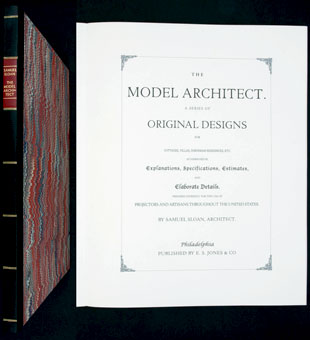 The Model Architect By Karen Hanmer Glenview, Illinois: Karen Hanmer, 2009. Edition of 30. 14 x 11 x .5"; 48 unnumbered pages. Pigment inkjet prints, calf spine, leather label, title and tooling in gold foil, red acrylic ink edges. Marbled paper by Iris Nevins. Two texts, one promoting self-glorification by way of home architecture and the other outlining the blueprint of contemporary foreclosure, are combined into one cautionary tale. Karen Hanmer: "The Model Architect: The Panic Of '09 is based on The Model Architect, Samuel Sloan's 1852 collection of house plans and instructions to contractors. The new work pairs historical text and illustrations from Sloan's work with contemporary text from the U.S. Department of Housing and Urban Development's online Guide to Avoiding Foreclosure. "The book is bound using the drum leaf structure, but is evocative of a mid 19th century binding in its use of materials and decorative elements: leather spine, marbled paper, decorated edge, gold tooling, and titling. The large page size mirrors that of Sloan's work. The Model Architect: The Panic Of '09 is one of six winners of the Building by the Book competition sponsored Philadelphia Athenaeum and Philadelphia Center for the Book. Karen Hanmer, Colophon: "Samuel Sloan's The Model Architect was published at the mid point of a century marked by cycles of rampant speculation followed by financial collapse. The Panic of 1857 came on the heels of publication of Sloan's work, and put a halt to the most active portion of his career. "This milieu mirrors what has happened in my own neighborhood of modest homes over the past fifteen years. The transformation began with some owners remodeling their kitchen, or adding a family room or bedroom. Then larger additions came. Ultimately, the houses commanded high prices to be sold as teardowns. Huge new houses were built in their places. "The construction proceeded with increasingly grandiose features; portions of the facade faced with thin sheets of stone, wooden garage doors with cast iron-like fittings, decorative copper accents on the roofs, turrets, lions flanking the brick driveways. "Now the house across the street, the house next door, and the house next door to that are all in foreclosure, and soon will be uninhabitable. The lawns grow without interruption. Without electricity and heat the basements fill with water, the pipes burst, the mechanicals are destroyed. Few modest, affordable homes remain in the neighborhood." |